On the Menu:
Tomatoes Stuffed with Brown Shrimp
Waterzooi from Ghent
Belgian Chocolate Mousse
This is no-frills classic Belgian cuisine.
The shrimp stuffed tomatoes in particular feature on every brasserie menu in the Flanders.
I’d argue that Waterzooi is the most iconic of the three though. It literally translates as “water mess”. Which is apt. But the term “zooi” actually came from the Flemish medieval word “zode” or “soot”, meaning “to boil”.
Indeed, the origins of this dish herald back as far as medieval times, when the Flemish living on the flatlands near the rivers Schelde and Leie boiled river fish in a pot with basic vegetables to sustain and survive.
Legend has it that the rivers near the Flemish city of Ghent became so polluted, the citizens of Ghent began to replace fish with chicken, as there were a lot of chicken farms in the area.
So if you see Waterzooi on a menu, it could be a fish version. Ask. If it says Ghent Waterzooi, it is definitely chicken based. The delicate fish version is my personal favourite. I’ll share my “quick-fix” Waterzooi of fish another time. But as the Ghent version is more popular these days (and I had a chicken lurking around), I opted for that one today.
Waterzooi from Ghent is a light soup-like stew of chicken, leek, celery, carrot and potato, gently thickened with a liaison of egg yolks and cream. Some parsley to garnish. That’s it.
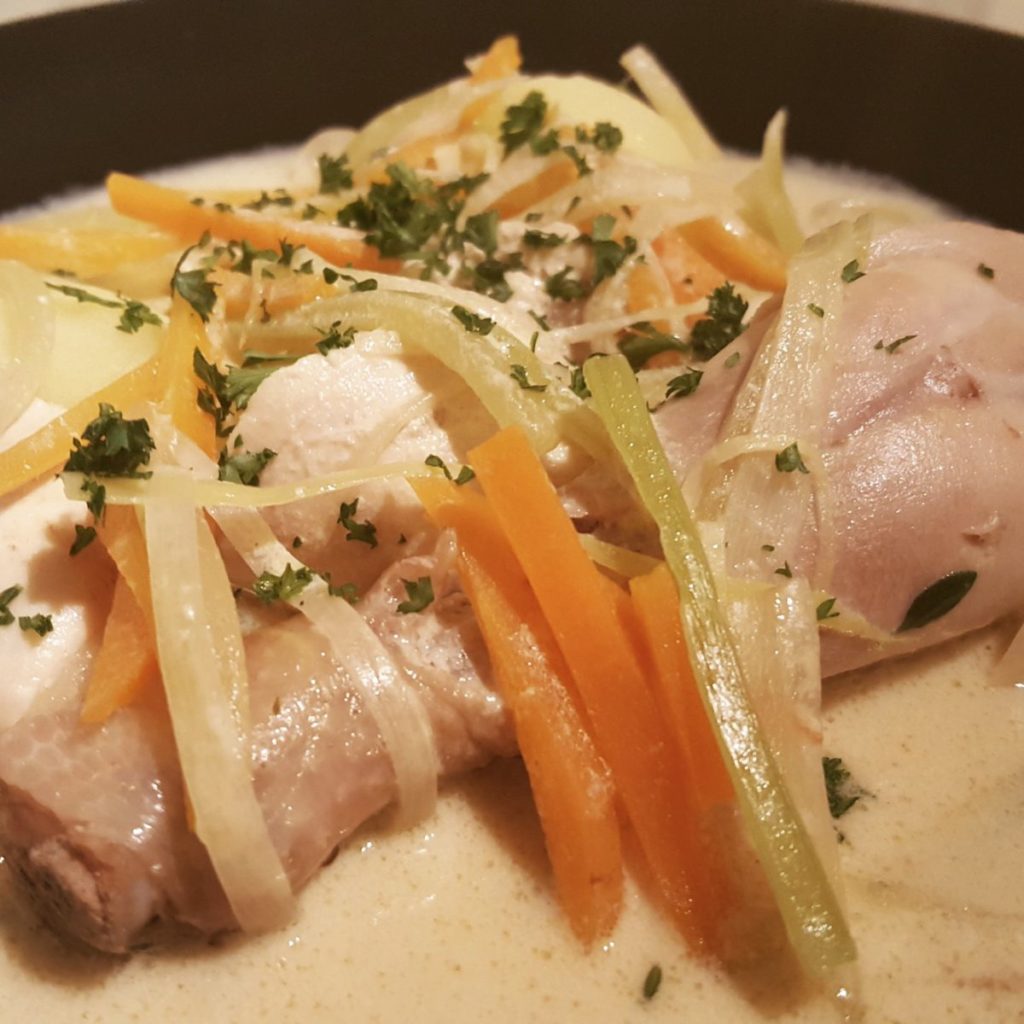
With something so basic, everything stands or falls by the quality of the ingredients. The plumpest chicken, home-made stock, organic vegetables, good butter and old-fashioned curly parsley rather than the trendier flat leaf. For this dish, I even do what I rarely do: I peel the potatoes! What you’re looking for, is a marriage of simple flavours in muted pastel colours.
Tomates Crevettes (Tomatoes stuffed with brown shrimp) is yet another classic best not to be messed with. As this dish only has 3 key ingredients, there is nowhere to hide.

This is traditionally made with the freshest North Sea brown shrimp, painstakingly peeled moments before meeting a dash of home-made mayonnaise and being stuffed into the juiciest of tomatoes.
So this is not the time to whip out frozen BOGOF Atlantic prawns. This is not the time to stint on the tomatoes. And this is definitely not the time to rely on mediocre mayonnaise from a jar.
Now then. Chocolate Mousse. Proper Belgian Chocolate Mousse. Been there, done that, bit Sixties, right? Wrong. A well-made chocolate mousse is still a treasure to behold. A memory of simpler times all-but-forgotten.
Sadly adding colour to an anecdote with my usual over-enthusiastic gesticulation, caused me to knock mine over part way through the indulgence.

There was a sharp intake of breath across the table.
“O no”, one of my guests cried out. “That’s SUCH a shame!!”
I looked at her with the obvious question in my eyes.
“Wasting that mousse! Forget the glass. What about the waste of that gorgeous mousse!”, she exclaimed.
My sentiments exactly.
On the bright side, this tragedy did provide an unusual angle to show off the incredibly airy texture of this mousse. Every cloud and all that.
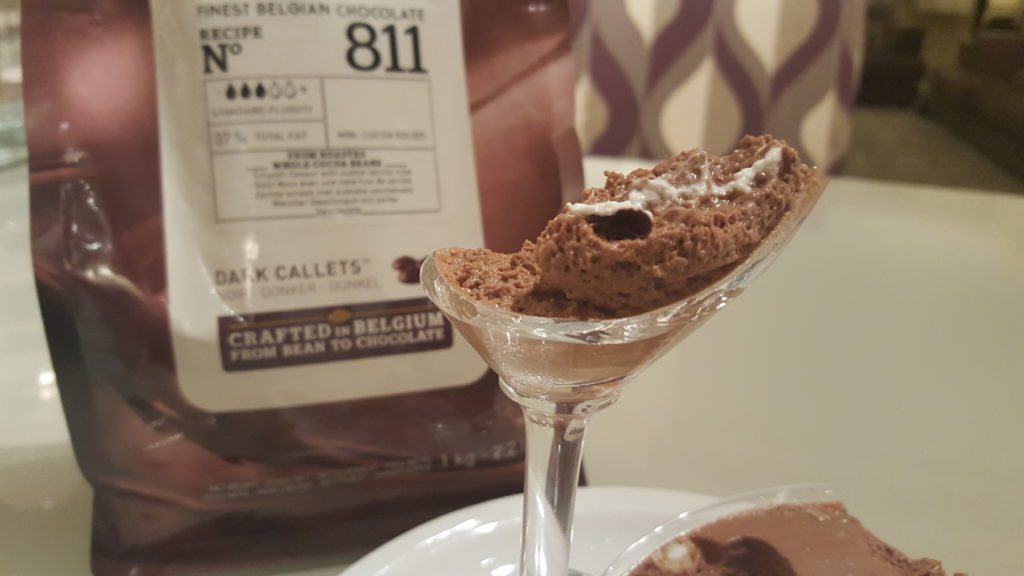
If you’re recreating this menu, don’t forget the classic Belgian café style “canapés”: cubes of mild cheese and salami with mustard for dipping. Traditionally smooth Dijon, so forgive my venturing out with some wholegrain as well.
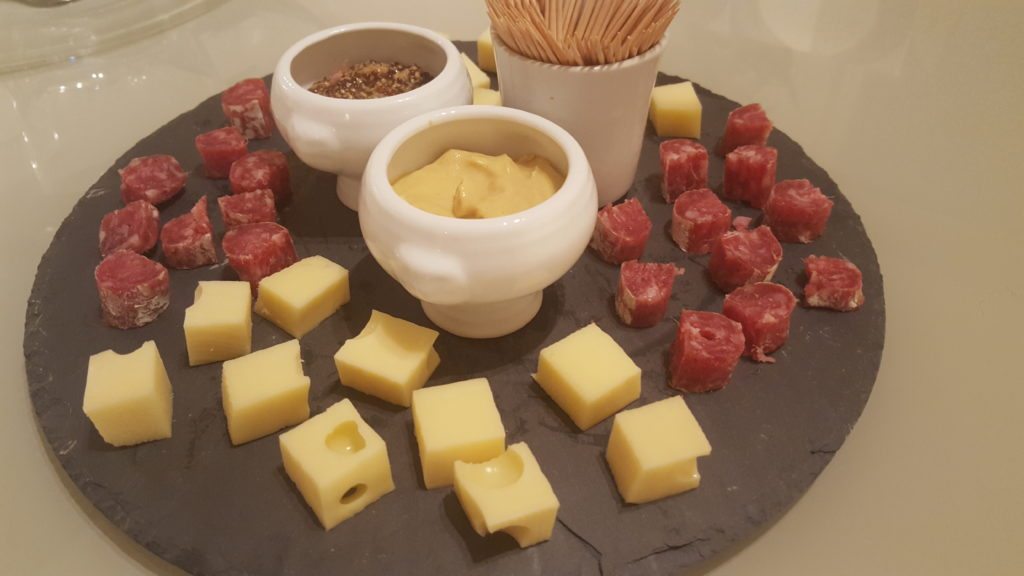
I am presenting the purist version of these dishes here. Obviously, you can let your imagination run wild and conjure up endless variations. But it’s also nice to treat the originals with the respect they deserve.
These are classics for very good reason after all.
THE RECIPES
Tomates Crevettes (Tomatoes stuffed with Brown Shrimp) (serves 4 – GF DF LC RSF)

Ingredients
8 tomatoes (Beef tomatoes are traditional, but only serve 1 each if they are huge)
1-2 tbsp good mayonnaise (recipe below)
450 gr brown shrimp, peeled
Juice of ½ a lemon
A little olive oil
A little curly parsley, a few sprigs for garnish, the rest finely chopped
S&P
Method
Remove any stalks and cut out the tough crown from each tomato. Cut a cross into the top of each tomato, not too deep.
Pour boiling water into a large bowl. Have another bowl filled with ice cold water at the ready next to it.
Immerse the tomatoes in the boiling water for 10-15 secs. Not too long or they will go mushy.
Remove and immediately dump into the iced water. After a minute or so, carefully skin the tomatoes, leaving them otherwise intact.
Cut a generous top off each tomato, keeping them with “their” tomato, so you know which hat belongs to which tomato.
Hollow out each tomato with a teaspoon or melon baller, removing the “ribs” too. Place upside down on kitchen paper while you do the rest. Hollow out the hat too. The scooped out bits can be discarded.
Dry the inside of each tomato and the underside of each hat with kitchen paper. Cut a tiny slice off the bottom of each tomato to enable them to stand securely upright, without breaking into the “bowl” you have now created. Still keep them so you know which hat belongs to which tomato.
Paint the outside of each tomato and hat with a little olive oil for shine.
If your shrimp have been frozen, firmly squeeze out any excess water before using.
Keep a few shrimp behind for garnish, mix the rest with the mayonnaise. Start with less mayonnaise than you think you’ll need, mix trough, and you’ll likely find that is plenty. A light coating is enough, no swimming here.
Add the chopped parsley and lemon juice to taste. Season. You won’t need a lot of salt, as the shrimp already taste of the sea. Also, back in the day, white pepper (or sneeze powder as I call it) was de rigeur. So I use white pepper for this one.
Carefully stuff the shrimp mixture into the tomatoes, and top each with its tomato hat. Don’t do this too long before serving. Best not eaten fridge cold.
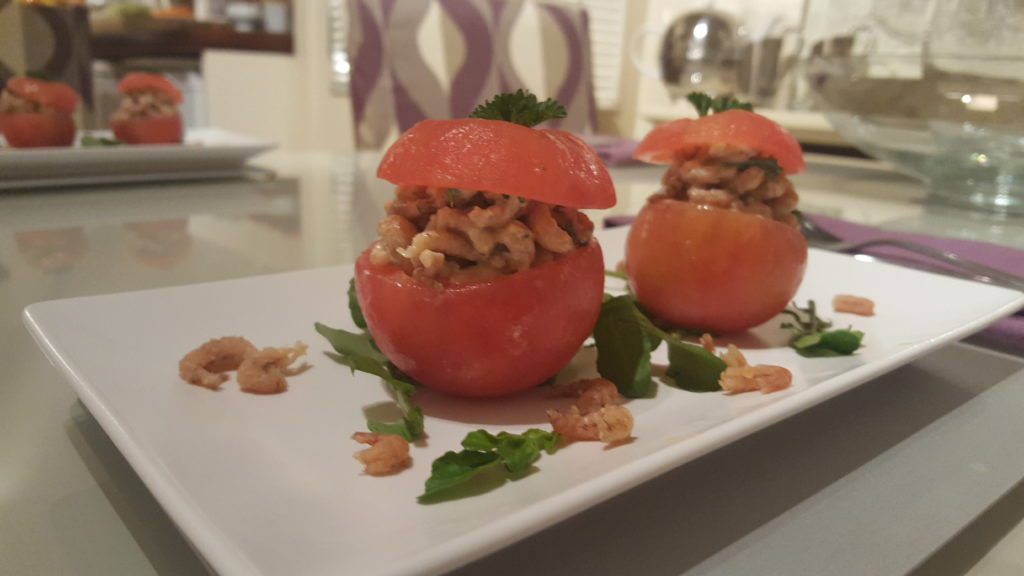
Serve 2 tomatoes per person as a starter with a few extra shrimp scattered about, some green leaves and a little parsley. For lunch, serve atop a mixed salad with a quartered hard-boiled egg. For dinner, serve with a side salad and chips. Lots of them.
Any left over shrimps, mayonnaise and greenery make a fabulously juicy sandwich on some toasted grain bread the next day.

Mayonnaise (makes approx. 200 ml – GF LC DF RSF)
Make sure all your ingredients are at room temperature. You could use a food processor or blender version such as Delia’s if preferred. That will yield a slightly thinner mayonnaise, but that’s OK for this recipe.
I find olive oil mayonnaise too strong and oily, and the rapeseed oil version a little bitter. So I always use a neutral oil such as groundnut oil.
Follow your mood though, and depending on what you need the mayonnaise for, replace the last 30 ml with olive oil, rapeseed oil or a flavoured oil (pumpkin, pistachio, walnut, truffle, flax, avocado etc).

Ingredients
1 large egg yolk (I used duck egg which enhances the colour)
A good pinch of sea salt
1-2 tsp Dijon mustard
Juice of ½ a lemon or 1 tbsp white wine vinegar
approx. 180 ml groundnut oil
Method
Whisk the egg yolk (by hand or using an electric whisk) for half a minute.
Add the salt and whisk again for half a minute or so until the yolk is slightly thick and sticky.
Add 1 tbsp of the lemon juice (or vinegar) and 1 tsp of mustard. Whisk again.
Keep whisking vigorously and start adding the oil a few drops at the time. As the mixture starts to thicken, increase the oil to a slow steady steam while you keep whisking. The key to your success is this slow steady stream of oil, else the mixture will split.
If it does split, start again, slowly and steadily adding the curdled mixture to a fresh egg yolk instead of the oil.
Adjust with more lemon juice and/or mustard to taste if needed.
If you like your mayonnaise thinner, you can let it down with a little water. If you like a lighter mayonnaise, mix through some yoghurt.
This basic mayonnaise can be flavoured with crushed garlic, fresh herbs, anchovy essence, grain mustard, horseradish, saffron or whatever suits your mood that day.
Waterzooi from Ghent (serves 4 – GF RSF)
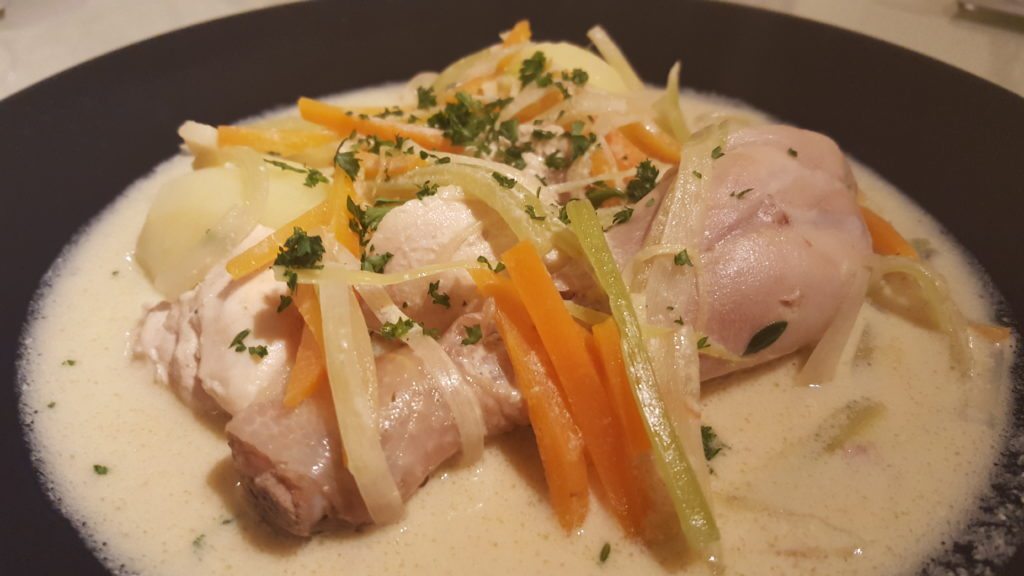
The traditional recipe uses an all-in one-method, cooking the chicken pieces for the final dish together with the soup base. The stock is strained through a fine sieve, reserving the stock. The edible chicken pieces are fished out of the sieve, skinned and then used in the final dish preparation.
I find this results in overcooked chicken. And fishing out and skinning hot chicken from a sieve full of carcass and hot veg is not my favourite pastime.
So I have reinvented the method to ensure the chicken is not dead on arrival.
My recipe uses a “triple stock”: make a well-flavoured chicken stock using a light vegetable stock instead of water. Then use that double stock to poach the chicken before using in the final dish.
Please don’t be put off by the long list of ingredients. It’s because it is split in a soap base and final dish ingredients. One whole chicken, a handful of herbs, a bag of carrots, 2 leeks and a celery will sort you out for both.
Ingredients
For the stock base:
The carcass and wings from 1 jointed chicken (the breasts and legs will be used in the final dish)
1.5 l vegetable stock
The greens of 2 leeks
1 onion, peeled and quartered
3 sticks of celery including the leaves
A good bunch of parsley, including the stalks
2 carrots, roughly chopped
A few bay leaves
Some fresh thyme
A few black peppercorns
For the final dish:
500 gr waxy potatoes such as Yukon Gold, peeled and halved lengthwise
The skinned breasts, drumsticks, and de-boned thighs from the jointed chicken used in the soup base
A generous tbsp of butter
2 leeks, inner whites only, cut into julienne
2-3 sticks of celery, peeled to remove the fibrous stuff and cut into julienne
2-3 carrots, peeled and cut into julienne
The reserved stock, hot
Some fresh thyme
A few bay leaves
A little freshly grated nutmeg
200 ml single cream
2 egg yolks
S&P (I use white pepper for this one)
Finely chopped parsley to garnish

Method
For the soup base:
Add the soup base ingredients to a large pan and bring to the boil. Once boiling, turn down the heat and simmer gently, skimming often, for up to 3 hours. Strain through a fine sieve or muslin, reserving the stock. You can do this in advance and chill. Remove any fat before using in the final dish preparation.
For the final dish
Par-boil the potatoes for 10-15 mins. Drain and reserve.
Bring the sieved stock and thyme leaves to a boil in a large pan.
Note the next poaching timings are approximate depending on the size of the individual chicken pieces, and your preference of done-ness. At this stage you want the chicken to be just under where you’d like them to be for serving.
Add the drumsticks to the stock and turn the heat down to low. Simmer for 10 mins. Add the chicken thighs and continue to simmer for 5 mins. Add the skinned chicken breasts and cook for another 10 mins.
Strain through a fine sieve or muslin and reserve the stock.
Meanwhile melt the butter a wide pan that can sit the chicken pieces and potatoes comfortably side by side on a medium heat. When foaming, add the vegetable julienne.
Turn the heat to medium low and sweat for 5 mins. Add the potatoes and season generously. Add a few serving spoons of stock, turn the heat down to low, cover and continue to sweat for another 5 mins or so.
Add the chicken pieces and enough of the hot stock to cover. Add 2/3 of the cream and a little nutmeg. Stir, cover and simmer until everything is cooked through, approx 10-15 mins.
Mix the egg yolks with the remaining cream (liaison). Quickly mix the liaison through the stew, ensuring the egg does not curdle. Check the seasoning. Turn off the heat.
To serve, halve or thickly slice the chicken breasts and divide with the other chicken pieces over 4 deep plates. Add some potato to each and arrange the vegetable julienne over and around. Generously spoon over plenty of the creamy broth.
Garnish with finely chopped parsley. Serve with soup spoons or bread for the juices.
If you have leftovers, serve as a hearty soup the next day. Blend the creamy broth and any left over stock with the potato and vegetables. Top with shredded leftover chicken. Be careful when reheating though, as the egg in the broth will curdle if boiled or overheated.

Belgian Chocolate Mousse (serves 4 – GF RSF V LC)

Use a good dark Belgian chocolate with cocoa solids between 52 and 70%. Anything higher than 70% will be too bitter and affect the smooth texture you’re looking for. I like Callebaut N811 nibs (54.5%). It provides that magic balance between a delicious chocolate hit and creamy lightness.

Ingredients
100 gr dark Belgian chocolate
3 large eggs (I used duck eggs with their large yolks)
50 gr Eritritol (or caster sugar) plus a scant tbsp for the whipped cream garnish (I used Natvia)
125 ml whipping cream plus 75 ml for the whipped cream garnish
A few dark chocolate curls for garnish (optional)
Method
Bring a good layer of water to a boil in a pan, then turn down to a simmer. Break the chocolate into small pieces and add to a round heatproof bowl that will fit nicely on top of the water pan, without the bottom touching the water (this is called a Bain Marie).
Let the chocolate gently melt, and take off the heat just before you think it has all melted. A gentle stir with a wooden spoon will sort out the final melting. Doing this reduces the risk of overcooking and the chocolate getting grainy.
Meanwhile, separate the eggs into yolks and whites.
Whisk the yolks until starting to thicken. While whisking, gradually add the sugar until the eggs and sugar are combined. Continue whisking until the sugary yolks are very thick and very pale (8 – 10 mins or so).
Use a spatula to mix the slightly cooled chocolate into the thickened yolks.
In a separate clean bowl, whisk the egg whites until very stiff. Any grease or yolk will prevent them from thickening. A good trick is to rub a halved lemon around the bowl and dry off with clean kitchen paper to ensure the bowl is squeeky clean.
Use the spatula to add ¼ of the egg whites to the chocolate mix to loosen the mixture. You don’t need to be too candid about this bit.
Use a large metal spoon to gently cut and fold through the remaining ¾ of egg whites.
Whisk 125ml cream to a soft set. You don’t want stiff peaks here, but just holding a nice oozy shape. Gently cut and fold through the delicate chocolate mix with your metal spoon, so as not to break up the egg whites.
Divide over 4 glasses or ramekins. Chill in the fridge for a couple of hours at least, but these will happily sit overnight.
For serving, whip the remaining cream with a scant tbsp of sugar until stiff but not buttery. Pipe or spoon onto each mousse.
Decorate with chocolate curls if you’re feeling fancy.





